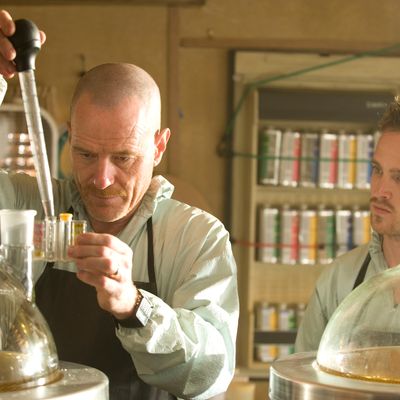
Meth could never be as blue as Walter WhiteÔÇÖs signature Blue Sky meth. ÔÇ£When you crystallize anything thatÔÇÖs colorless, which methylamine crystals are, they usually come out with a yellow tinge because of impurities,ÔÇØ says Dr. Donna Nelson, a professor of chemistry at the University of Oklahoma. Unlike most chemists who grumble about molecular errors they spot while watching TV, however, Nelson has a forum to do something about it: She has been volunteering as Breaking BadÔÇÖs science adviser since season two, making sure that WaltÔÇÖs science lectures (and pedantic tutorials to Jesse) actually made sense. But just because she deals with hard facts as a scientist doesnÔÇÖt mean that she isnÔÇÖt willing to grant artistic license. While she did tell show creator Vince Gilligan that the methÔÇÖs ÔÇ£blue was a little too blue,ÔÇØ she recalls that ÔÇ£I think he wanted Walt to have a trademark. So, itÔÇÖs a little exaggerated. ThatÔÇÖs OK. ItÔÇÖs not supposed to be 100 percent factual.ÔÇØ
Nelson first made contact with Gilligan after reading an interview he gave to Chemical & Engineering News in which he admitted the show was in need of some assistance when it came to making Walt a believable chemistry wonk. ÔÇ£I thought, hey, this is an opportunity to build a bridge,ÔÇØ she said. ÔÇ£I knew how much the chemistry community wanted to see correct science in movies and television, and that they also wanted to see scientists presented appropriately.ÔÇØ Too long has popular media been getting it wrong, she said. Like when a rocket ship is seen flying through space ÔÇ£and you can see the smoke coming out of the rocket and itÔÇÖs rising,ÔÇØ she laughs. ÔÇ£We know itÔÇÖs ridiculous.ÔÇØ
Her main job has been not so much to scrutinize WaltÔÇÖs meth cooks, but to make sure he walks and talks like a real, PhD-wielding organic chemist. During her first meeting with the writers, she was asked to flesh out WaltÔÇÖs history; Gilligan quizzed her on why a person would pursue science professionally, and how a brilliant scientist might wind up as a high school teacher. During filming, sheÔÇÖd make herself available for quick-turnaround questions about balancing equations and calculations. One of her first projects was redoing a lecture Walt was giving to his class on alkyne nomenclatures. ÔÇ£It was clearly not written by a chemist,ÔÇØ she said. ÔÇ£I wrote them back some general information, like a ÔÇÿHow Do You Learn Alkyne Nomenclature in Under Two MinutesÔÇÖ memo, and I was really shocked when they used it as dialogue almost verbatim.ÔÇØ The show even recreated diagrams she drew, putting them on WaltÔÇÖs white board. Sometimes, the writers would call Nelson with ÔÇ£dialogue emergencies.ÔÇØ ÔÇ£When Walt would be speaking to Jesse, theyÔÇÖd want to know that the phraseology was correct, but also to make sure that Walt was really speaking in a way that a chemistry teacher would speak to a student or a subordinate,ÔÇØ Nelson said. ÔÇ£They were interested in not just lab terminology but getting the flavor of the conversation right because, at least initially, Walt and Jesse were not equals.ÔÇØ
For the most part, however, sheÔÇÖs left the actual meth production evaluations to the Drug Enforcement Administration, which participates in making sure WaltÔÇÖs illegal labs look legit (ÔÇ£Quite honestly, I wouldnÔÇÖt know about that,ÔÇØ she said) and but donÔÇÖt provide an actual tutorial. She says theyÔÇÖve been crafty in how theyÔÇÖve made the process faulty while keeping it realistic. ÔÇ£ItÔÇÖs a valid synthesis, the way theyÔÇÖre using methylamine,ÔÇØ she says. ÔÇ£That process was patented in Germany in 1957. ItÔÇÖs a very old method. They arenÔÇÖt revealing anything new. What they are doing is leaving out steps. Or sometimes they show some steps from one synthesis and subsequent steps from another synthesis, which prevents Breaking Bad from becoming an illegal meth cookbook.ÔÇØ

